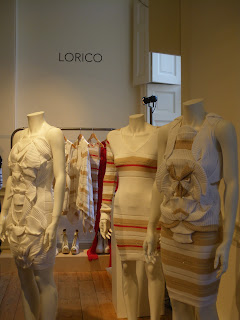Give it a few more seasons and
sustainable fashion will come into its own. The latest outing of Esthetica at
London Fashion Week saw eco-fashion longer on design and lesser on the pieties,
signaling an exciting and bankable future for ethical fashion and fair trading
practices.
The 15 designers invited by the British
Fashion Council to show their sustainable fashion collections at Somerset House
not only gave good green but great ideas as well. This is just what eco-minded
fashion needs – design-driven excitement, not just conscience.
There was certainly a lot of interest
around Jerome Lorico’s collection of knitted sheaths inspired by Inca
sacrificial virgins. With intricately folded bodices, robe-like protrusions and
trains, the dresses would catch the fancy of any It Girl looking for fabulosity
on a night prowl. Or anyone with an eye toward high feminine seduction.
Lorico, who designs home décor and
paints as well, has a constructivist’s sensibility for shape and form. He also
has an intuitive feel for sensuality. The combination makes for a fresh,
innovative and exhilarating collection by any reckoning - the most frequent
comment heard from buyers and press who happened by his space: “Amazing”.
There’s a bit of handcrafting here, with
the bodices painstakingly folded by the designer to resemble Inca armour. But
the real sustainability element is how he ingeniously combined cotton with
pineapple fiber, an organic fiber used for traditional textiles in the
designer’s native Philippines.
Pineapple fiber is normally made into a
special, light and airy, handcrafted fabric used for formal wear (especially
for the traditional men’s formal shirt, the Barong Tagalog, check any
photograph of the Philippines president at work), but has limited commercial
fashion use. The production of pina
fabric in the Philippines is a treasured cultural heritage and a cottage
industry in a clutch of regional communities. However, like most traditional
crafts, it is in danger of dying out, if the craft cannot sustain the interest
of the next generation of pina
weavers.
By combining cotton knit with 30 percent
pineapple fiber, Lorico has hit upon the idea of how to make knitwear lighter
but more heat-retentive and has found a potentially lucrative commercial application
for the pineapple fiber as well. “It
improves the properties of knitwear and at the same time it offers greater
income opportunities for pina-weaving communities,” he says. “I truly believe
this has global potential.”
Last season, Lorico exhibited men’s
knitwear using the same material as part of the global fashion showcase.
